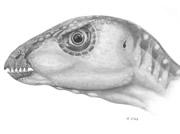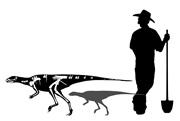 An artist's impression shows the "digging runner of the lair" had a broad snout for burrowing.Lee Hall
An artist's impression shows the "digging runner of the lair" had a broad snout for burrowing.Lee HallThe discovery of a dinosaur family fossilized in its burrow could make us rethink where the animals lived, how they behaved, and even what wiped them out, say researchers.
David Varricchio of Montana State University in Bozeman and his colleagues found the jumbled remains of two juveniles and an adult together in what looks to be the remains of a custom-built hole in southern Montana.
The discovery provides the first evidence that dinosaurs could burrow, and the best evidence yet for long-term parental care in dinosaurs, says team member Anthony Martin, an expert in animal traces at Emory University in Atlanta, Georgia. "I imagine that two juveniles curled up in a small space with an adult," he says.
The team has named the beast Oryctodromeus cubicularis, meaning 'digging runner of the lair'. It belongs to a group of small herbivorous dinosaurs, and lived 95 million years ago during the mid-Cretaceous period.
The skeletons are incomplete, but they show that when fully grown, the animal was about 2.1 metres long, of which more than half was tail. The dinosaur had a broad snout and powerful shoulders well adapted for digging, and sturdy hips that would help it to brace itself as it dug. It could also run on its back legs.
Secret entrance
The burrow's presence was betrayed by a patch of rock that differed from its surroundings, in an area known to contain dinosaur fossils. The burrow seems to have been dug on the edge of a river flood plain and filled with mud during a flood, burying its occupants, the researchers report in Proceedings of the Royal Society1.
 Dig this: an adult Oryctodromeus cubicularis (far left) was probably 2.1 metres long.Lee Hall
Dig this: an adult Oryctodromeus cubicularis (far left) was probably 2.1 metres long.Lee HallThe den was just over two metres long, with a pronounced s-bend — making it harder for predators to enter — opening out into a terminal chamber. The close fit between the sizes of burrow and beast convinced the team that Oryctodromeus had dug its own den, rather than simply displacing a previous occupant. "It's not just a random attempt," says Martin. "It's very well constructed."
"It was generally assumed that dinosaurs wouldn't dig — they tend to be either runners or very large," says palaeontologist Paul Barrett of the Natural History Museum, London. "This is quite a departure."
Varricchio and his colleagues had previously found what seemed to be a family of dinosaurs in what could have been a collapsed burrow in China (see 'Fossil hints at devoted parenting in dinosaurs'), but no one had seen an actual tunnel space until now.
Safe underground
Burrowing may have helped dinosaurs to survive in harsh climates, increasing the range of habitats available to them. No one knows exactly what the environment of this part of the world was like when these dinosaurs lived there, although it was probably semi-arid.
Related dinosaurs are known to have lived in southern Australia, which was close to the South Pole at the time, and South Africa, which was hot and dry. These species and locations would be good places to look for further evidence of burrowing, says Barrett.
ADVERTISEMENT
The lack of an ability to burrow has also been suggested as a factor in the demise of dinosaurs 65 million years ago, at the end of the Cretaceous. Many of the mammals, reptiles and amphibians that survived a mass extinction at this time could burrow, perhaps sheltering them from whatever catastrophe caused the massive cull.
"The absence of burrowing has been proposed as one reason why dinosaurs didn't make it," says Martin. "You can't use that as a reason now."
Using one specimen to speculate about the dinosaurs' extinction is "quite a big inference", says Barrett. "It might be taking the data too far," he cautions.
Visit our dinosaurunearthed.html">newsblog to read and post comments about this story.
